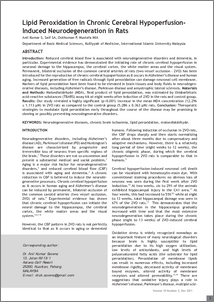Saxena, Anil Kumar and Abdul Majeed, Saif Saad and Oothuman, Pakeer and Mustafa Mahmoud, Mohammed Imad Al-Deen
(2011)
Lipid peroxidation in chronic cerebral hypoperfusion-
induced neurodegeneration in rats.
International Medical Journal Malaysia, 10 (2).
pp. 3-6.
ISSN 1823-4631
![[img]](http://irep.iium.edu.my/style/images/fileicons/application_pdf.png)  Preview |
|
PDF (Lipid peroxidation in chronic cerebral hypoperfusion)
- Published Version
Download (88kB)
| Preview
|
Abstract
Introduction: Reduced cerebral blood fl ow is associated with neurodegenerative disorders and dementia, in particular. Experimental evidence has demonstrated the initiating role of chronic cerebral hypoperfusion in
neuronal damage to the hippocampus, the cerebral cortex, the white matter areas and the visual system.
Permanent, bilateral occlusion of the common carotid arteries of rats (two vessel occlusion - 2VO) has been
introduced for the reproduction of chronic cerebral hypoperfusion as it occurs in Alzheimer’s disease and human
aging. Increased generation of free radicals through lipid peroxidation can damage neuronal cell membrane.
Markers of lipid peroxidation have been found to be elevated in brain tissues and body fluids in neurodegenerative diseases, including Alzheimer’s disease, Parkinson disease and amyotrophic lateral sclerosis. Materials and Methods: Malondialdehyde (MDA), final product of lipid peroxidation, was estimated by thiobarbituric
acid-reactive substances (TBARS) assay kit at eight weeks after induction of 2VO in the rats and control group.
Results: Our study revealed a highly signifi cant (p<0.001) increase in the mean MDA concentration (12.296 ± 1.113 ìM) in 2VO rats as compared to the control group (5.286 ± 0.363 ìM) rats. Conclusion: Therapeutic strategies to modulate lipid peroxidation early throughout the course of the disease may be promising in slowing or possibly preventing neurodegenerative disorders.
Actions (login required)
 |
View Item |


 Download Statistics
Download Statistics Download Statistics
Download Statistics